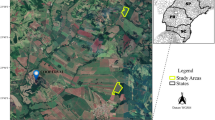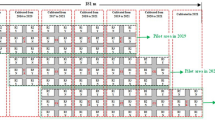Abstract
The adoption of mechanical harvesting of green cane gives rise to concerns as to whether systems developed under burnt cane harvesting are applicable to a green cane harvesting system. In particular, tillage, which is an integral part of the burnt cane system, may no longer be necessary, and the nitrogen fertilizer rates required may need to be replaced due to the large amounts of organic matter being returned to the soil after green cane harvesting. Mechanical harvesting is relatively new in Brazil and little is known about its effect on other sugarcane production strategies. This work aimed to evaluate sugarcane performance under not only different harvesting and cultivation systems, but also different nitrogen fertilizer rates over a 3-year period. The experimental design was a split plot with harvesting systems (burnt vs. green) as main plots, cultivation (interrow vs. no cultivation) as sub plots, and nitrogen rates as sub-sub plots. The harvesting systems produced similar sugarcane yields throughout the experimental period, which demonstrates that the harvest systems do not influence sugarcane yield. Mechanical tillage practices in interrow after harvesting had no impact on stalk yield or sugar quality, indicating no necessity for this operation in the following crop. Ratoon nitrogen fertilization promoted an increase of stalk and sugar yield, with highest yields obtained at the rate of 130 kg ha−1 N. However, there was no interaction between harvesting system and nitrogen rate.




Similar content being viewed by others

References
Belardo GC, Cassia MC, Silva RP (2015) Processos Agrícolas e Mecanização da Cana-de-Açúcar. Sociedade Brasileira de Engenharia Agrícola SBEA, Jaboticabal 608p
Franco HCJ, Pimenta MTB, Carvalho JLN, Magalhães PSG, Rossell CE, Braunbeck OA, Vitti AC, Kölln OT, Rossi Neto J (2013) Assessment of sugarcane trash for agronomic and energy purposes in Brazil. Sci Agric 70(5):305–312. https://doi.org/10.1590/S0103-90162013000500004
Ferreira DA, Franco HCJ, Otto R, Vitti AC, Fortes C, Faroni CE, Garside AL, Trivelin PCO (2016) Contribution of N from green harvest residues for sugarcane nutrition in Brazil. GCB Bioenergy 8(5):859–866. https://doi.org/10.1111/gcbb.12292
Menandro LMS, Cantarella H, Franco HCJ, Kölln OT, Pimenta MTB, Sanches GM, Rabelo SC, Carvalho JLN (2017) Comprehensive assessment of sugarcane straw: implications for biomass and bioenergy production. Biofpr 11(3):488–504. https://doi.org/10.1002/bbb.1760
Landell MGA, Scarpari MS, Xavier MA, Anjos IA, Baptista AS, Aguiar CL, Silva DN, Bidoia MAP, Brancalião SR, Bressiani JA, Campos MF, Miguel PEM, Silva TN, Silva VHP, Souza Anjos LO, Ogata BH (2013) Residual biomass potential of commercial and pre-commercial sugarcane cultivars. Sci Agric 70(5):299–304. https://doi.org/10.1590/S0103-90162013000500003
Basanta MV, Dourado Neto D, Reichardt K, Bacchi OOS, Oliveira JCM, Trivelin PCO, Timm LC, Tominaga TT, Correchel V, Cássaro FAM, Pires LF, Macedo JR (2003) Management effects on nitrogen recovery in a sugarcane crop grown in Brazil. Geod 116:235–248. https://doi.org/10.1016/S0016-7061(03)00103-4
Prado RM, Pancelli MA (2008) Sugarcane ratoon response to nitrogen application in a no burn harvesting system. Bragantia 67:951–959. https://doi.org/10.1590/S0006-87052008000400018
Trivelin PCO, Oliveira MW, Vitti AC, Gava GJC, Bendassolli JA (2002) Nitrogen losses of applied urea in the soil-plant system during two sugar cane cycles. Pesq. Agropec. Bras. 37:193–201. https://doi.org/10.1590/S0100-204X2002000200011
Carvalho JLN, Otto R, Franco HCJ, Trivelin PCO (2013) Input of sugarcane post-harvest residues into the soil. Sci Agric 70(5):336–344. https://doi.org/10.1590/S0103-90162013000500008
Carvalho JLN, Nogueirol RC, Menandro LMS, Bordonal RO, Borges CD, Cantarella H, Franco HCJ (2017) Agronomic and environmental implications of sugarcane straw removal: a major review. GCB Bioenergy 9(7):1181–1195. https://doi.org/10.1111/gcbb.12410
Cerri, CC, Galdos, MV, Maia, SMF, Bernoux M, Feigl BJ, Powlson, D, Cerri, CEP (2011) Effect of sugarcane harvesting systems on soil carbon stocks in Brazil: an examination of existing data. Eur J Soil Sci 62:23–28. doi: https://doi.org/10.1111/j.1365-2389.2010.01315.x
Oliveira MW, Trivelin PCO, Gava GJC, Penatti CP (1999) Sugarcane trash degradation. Sci Agric 56:803–809. https://doi.org/10.1590/S0103-90161999000400006
Franco HCJ, Bologna IR, Faroni CE, Trivelin PCO (2007) Macronutrients accumulation in sugarcane crop related to nitrogen fertilization and cultural residues incorporated to the soil at planting. Bragantia 66:669–674. https://doi.org/10.1590/S0006-87052007000400017
Wood AW (1991) Management of crop residues following green cane harvesting of sugarcane in north Queensland. Soil Till Res 20:69–75
Bell, MJ, Halpin, N, Cunningham, G, Garside, AL, Kingston, G (1999) Effect of wet soil during early season ratoon establishment on sugarcane grown under different trash management systems in southern canelands. Proc. Aust. Soc. Sugar Cane Tech 21:139–148
Tavares OCH, Lima E, Zonta E (2010) Sugarcane growth and productivity under different tillage and crop systems. Acta Sci Agron 32:61–68. https://doi.org/10.4025/actasciagron.v32i1.2051
Dinardi Miranda LL, Fracasso JV (2013) Sugarcane straw and the populations of pests and nematodes. Sci Agric 70(5):305–310. https://doi.org/10.1590/S0103-90162013000500012
Fortes C, Vitti AC, Otto R, Ferreira DA, Franco HCJ, Trivelin PCO (2013) Contribution of nitrogen from sugarcane harvest residues and urea for crop nutrition. Sci Agric 70(5):313–320. https://doi.org/10.1590/S0103-90162013000500005
Robertson FA, Thorburn PJ (2007) Decomposition of sugarcane harvest residue in different climatic zones. Aust J Soi Res 45:1–11. https://doi.org/10.1071/SR06079
Gava GJC, Trivelin PCO, Vitti AC, Oliveira MW (2005) Urea and sugarcane straw nitrogen balance in a soil-sugarcane crop system. Pesq Agropec Bras 40:689–695. https://doi.org/10.1590/S0100-204X2005000700010
Vitti AC, Ferreira DA, Franco HCJ, Fortes C, Otto R, Faroni CE, Trivelin PCO (2010) Utilisation of nitrogen from trash by sugarcane ratoons. Sugarcane Internat 28:249–253
Fortes C, Trivelin PCO, Vitti AC, Ferreira DA, Franco HCJ, Otto R (2011) Recovery of nitrogen (15N) by sugarcane from previous crop residues and urea fertilisation under a minimum tillage system. Sug Tech 13(1):42–46. https://doi.org/10.1007/s12355-011-0074-4
Trivelin PCO, Franco HCJ, Otto R, Ferreira DA, Vitti AC, Fortes C, Faroni CE, Oliveira ECA, Cantarella H (2013) Impact of sugarcane trash on fertilizer requirements for São Paulo, Brazil. Sci Agric 70(5):345–352. https://doi.org/10.1590/S0103-90162013000500009
Penatti CP (2013) Adubação da cana-de-açúcar, 1a edn. Editora Ottoni, Piracicaba, SP
Cantarella H, Rossetto R (2014) Fertilizers for sugarcane. In: Cortez LAB (ed) Sugarcane bioethanol — R&D for Productivity and Sustainability. Edgard Blücher, São Paulo, pp 405–422
Otto R, Castro SAQ, Mariano E, Castro SGQ, Franco HCJ, Trivelin PCO (2016) Nitrogen use efficiency for sugarcane-biofuel production: what is the next? Bioen Res 9(4):1272–1289. https://doi.org/10.1007/s12155-016-9763-x
Garside AL, Poggio MJ, Park G, Salter B, Perna J (2009) Long-term Ingham and Mackay farming system experiments: comparison between non-tilled beds re-formed ceds. Proc. Aust. Soc. Sugar Cane Tech 31:282–295
Bianchini A, Magalhães PSG (2008) Evaluation of coulters for cutting sugar cane residue in a soil bin. Biosyst Eng 100(3):370–375. https://doi.org/10.1016/j.biosystemseng.2008.04.012
Souza ZM, Paixão ACS, Prado RM, Cesarin LG, Souza SR (2005) Residue management of the green sugarcane, productivity and broth quality of the sugarcane. R Ci Rur 35(5):1062–1068. https://doi.org/10.1590/S0103-84782005000500012
Oliveira VS, Rolim MM, Vasconcelos RFB, Costa YDJ, Pedrosa EMR (2010) Compactação de um Argissolo Amarelo Distrocoeso submetido a diferentes manejos. Rev B Eng Agric Amb 14(9):914–920. https://doi.org/10.1590/S1415-43662010000900002
Paulino AF, Medina CC, Azevedo MCB, Silveira KRP, Trevisan AA, Murata IM (2004) Chisel plowing in an Oxisol in post harvest of ratoon cane. R Bras Ci Solo 28(5):911–917. https://doi.org/10.1590/S0100-06832004000500013
Camilotti F, Andrioli I, Dias FLF, Casagrande AA, Silva AR, Mutton MA, Centurion JF (2005) Long-term effect of soil tillage systems with and without tillage of green-cane stump in soil physical properties. Eng. Agric 25(1):189–198. https://doi.org/10.1590/S0100-69162005000100021
Soil Survey Staff, (2014) Key to soil taxonomy, USDA-NRCS, agricultural handbook no. 436p. 12th ed. U.S. Government Printing Office, Washington, DC, USA
Fernandes AC (2003) Calculations in the sugarcane agroindustry. STAB, Piracicaba 260p
Cassia MT, Silva RP, Paixão CSS, Bertonha RS, Cavichioli FA (2014) Basecutter blades wear in quality of mechanized harvesting. Rev Ci Rural 44(6):987–993. https://doi.org/10.1590/S0103-84782014000600006
Reis, GN (2009) Perdas na colheita mecanizada da cana-de--açúcar crua em função do desgaste das facas do corte de base. Tese (Doutorado em Agronomia) – Faculdade de Ciências Agrárias e Veterinárias, Jaboticabal – SP 89p.
Souza GC, Souza ZM, Cooper M, Tormena CA (2015) Controlled traffic and soil physical quality of an Oxisol under sugarcane cultivation. Sci Agric 72(3):270–277. https://doi.org/10.1590/0103-9016-2014-0078. Científica, 34(1):31-38.
Segato, SV, Pinto, AS, Jendiroba, E, Nobrega, JCM (2006) Atualização em produção de cana-de-açúcar. Piracicaba: CP 2, 415p
Magalhães, PSG, Braunbeck, AO (2010) Colheita de cana-de-açúcar e palha. Cortez, LAB (Org.). Bioetanol de Cana-de-Açúcar, P&D para Produtividade e Sustentabilidade, Blucher São Paulo
Gray GR, Magalhães PSG, Braunbeck AO (2009) Pantographic suspension for sugar cane base cuter. Rev. Ci. Rural 39(3):766–771
Braida JA, Reichert JM, Veiga M, Reinert DJ (2006) Resíduos vegetais na superfície e carbono orgânico do solo e suas relações com a densidade máxima obtida no ensaio Proctor. Rev. Bras. Ci. Solo 30(4):605–614. https://doi.org/10.1590/S0100-06832006000400001
Otto R, Trivelin PCO, Franco HCJ, Faroni CE, Vitti AC (2009) Root system distribution of sugarcane as related to nitrogen fertilization, evaluated by two methods: monolith and probes. R. Bras. Ci. Solo 33(3):601–611. https://doi.org/10.1590/S0100-06832009000300013
Otto R, Franco HCJ, Faroni CE, Vitti AC, Trivelin PCO (2009) Sugarcane root and shoot phytomass related to nitrogen fertilization at planting. Pesq. Agropec. Bras. 44(4):398–405. https://doi.org/10.1590/S0100-204X2009000400010
Hurney AP, Schroeder B (2012) Does prolonged green cane trash retention influence nitrogen requirements of the sugarcane crop in the wet tropics. Proc. Aust. Soc. Sugar Cane Tech 34:1–9
Vitti AC, Franco HCJ, Trivelin PCO, Ferreira DA, Otto R, Fortes C, Faroni CE (2011) Nitrogen derived from fertilization and straw for plant cane nutrition. Pesq. Agropec Bras 46(3):287–293
Fortes C, Trivelin PCO, Vitti AC (2012) Long term decomposition of sugarcane harvest residues in Sao Paulo state, Brazil. Biomass Bioenergy 42:189–198. https://doi.org/10.1016/j.biombioe.2012.03.011
Oliveira APP, Thorburn PJ, Biggs JS, Lima E, Anjos LHC, Pereira MG, Zanotti NE (2016) The response of sugarcane to trash retention and nitrogen in Brazilian coastal tableland: a simulation study. Exper Agricult 52(1):69–86. https://doi.org/10.1017/S0014479714000568
Aquino GSD, Medina CDC, Porteira Junior AL et al (2015) Root system and productivity of sugarcane ratoon associated to different quantities of straw. Pesq. Agropec. Brassica 50(12):1150–1159. https://doi.org/10.1590/S0100-204X2015001200004
Castro SGQ, Franco HJC, Mutton MA (2014) Harvest managements and cultural practices in sugarcane. Rev Bras Ci Solo 38:299–306. https://doi.org/10.1590/S0100-06832014000100030
Oliveira APP, Lima E, Anjos LC, Zonta E, Pereira MG (2014) Sugarcane harvesting systems: current knowledge about modifications of attributes in tableland soils. Rev B Eng Agríc e Amb 18(9):939–947. https://doi.org/10.1590/1807-1929/agriambi.v18n09p939-947
Taiz L, Zeiger E (2009) Fisiologia vegetal, 4th edn. Artmed, Porto Alegre 819p
Thorburn PJ, Biggs JS, Webster AJ, Biggs IM (2011) An improved way to determine nitrogen fertiliser requeriments of sugarcane crops to meet global environmental challenges. Plant Soil 339:51–77. https://doi.org/10.1007/s11104-010-0406-2
Franco HCJ, Otto R, Vitti AC, Faroni CE, Oliveira ECA, Fortes C, Ferreira DA, Kolln OT, Garside AL, Trivelin PCO (2015) Residual recovery and yield performance of nitrogen fertilizer applied at sugarcane planting. Sci Agric 72(6):528–534. https://doi.org/10.1590/0103-9016-2015-0170
Rhein AFL, Pincelli RP, Arantes MP, Dellabiglia WJ, Kolln OT, Silva MA (2016) Technological quality and yield of sugarcane grown under nitrogen doses via subsurface drip fertigation. Rev Bras Eng Agríc Amb 20(3):209–214. https://doi.org/10.1590/1807-1929/agriambi.v20n3p209-214
Korndorfer GH, Valle MR, Martins M, Trivelin PCO (1997) Aproveitamento do nitrogênio da uréia pela cana-planta. Rev. Bras. Ci. Solo 21(1):23–26
Castro SGQ, Decaro Junior ST, Franco HCJ, Magalhães PSG, Mutton MA (2016) Best practices of nitrogen fertilization management for sugarcane under green cane trash blanket in Brazil. Sugar Tech 19(1):51–56. https://doi.org/10.1007/s12355-016-0443-0
Funding
This project was funded by FAPESP (State of São Paulo Research Foundation—Process 2013/01417-2), and CAPES (Higher Education Personnel of Improvement of Coordination), which supported the scholarship of the first author.
Author information
Authors and Affiliations
Corresponding author
Electronic Supplementary Material
Suppl. Fig. 1
(DOCX 41 kb)
Rights and permissions
About this article
Cite this article
Quassi de Castro, S.G., Graziano Magalhães, P.S., Coutinho Junqueira Franco, H. et al. Harvesting Systems, Soil Cultivation, and Nitrogen Rate Associated with Sugarcane Yield. Bioenerg. Res. 11, 583–591 (2018). https://doi.org/10.1007/s12155-018-9917-0
Published:
Issue Date:
DOI: https://doi.org/10.1007/s12155-018-9917-0



